Themed collection New Talent: Americas

Front cover
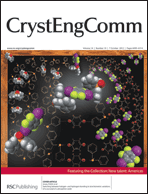
Inside front cover
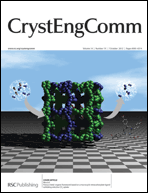
Contents list
New talent: Americas
Welcome to this New talent issue of CrystEngComm featuring a collection of papers that highlight young and talented scientists from the Americas.

CrystEngComm, 2012,14, 6109-6109
https://doi.org/10.1039/C2CE90073D
Structural bolstering of metal sites as nodes in metal–organic frameworks
We show that a metal site attains orders of magnitude higher resistance (compared to its molecular form) towards external ligand-induced disruption of its coordination environment upon incorporation as the building block of a crystalline metal–organic framework (MOF).

CrystEngComm, 2012,14, 6136-6139
https://doi.org/10.1039/C2CE25555C
Hydrogen bonded chiral sheet self-assembled from a C3-symmetric tricarbamate
A crystalline chiral sheet spontaneously assembled under mild conditions from benzene-1,3,5-triyl tris(propylcarbamate), which is a C3-symmetric supramolecular atropisomer. The lamellar-like structure was directly observed by TEM, and confirmed by powder and single crystal X-ray diffraction analysis.

CrystEngComm, 2012,14, 6132-6135
https://doi.org/10.1039/C2CE25487E
Stepwise pillar insertion into metal–organic frameworks: a sequential self-assembly approach
Stepwise linker insertion within pillared paddlewheel frameworks.

CrystEngComm, 2012,14, 6129-6131
https://doi.org/10.1039/C2CE25545F
Exploring the use of anionic homoleptic complexes as templates in the design of photoreactive multi-component supramolecular assemblies
A novel supramolecular approach based on the use of different homoleptic complexes as templates is explored in order to drive regioselective [2+2] cycloaddition in the solid state.

CrystEngComm, 2012,14, 6121-6125
https://doi.org/10.1039/C2CE25481F
Double-layered alcohol : controlling the macroscopic organization of small molecules through the self-assembly of their receptors
A family of macrocycles displays and organizes small alcohol substrates in a manner predicted by the rings' intrinsic self-assembly properties.

CrystEngComm, 2012,14, 6118-6120
https://doi.org/10.1039/C2CE25486G
Switching between halogen - and hydrogen-bonding in stoichiometric variations of a cocrystal of a phosphine oxide
Stoichiometric ratio of methyldiphenylphosphine oxide and p-diiodotetrafluorobenzene determines whether the resulting cocrystal will display hydrogen or halogen bonds.
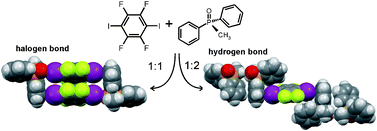
CrystEngComm, 2012,14, 6110-6114
https://doi.org/10.1039/C2CE25653C
Self-assembly of benzyl cyclopentadienyl lithium
The base-free polymeric superstructure of benzyl cyclopentadienyl lithium having the shortest Cp–Li bond distance of mono-substituted CpLi compounds is reported.
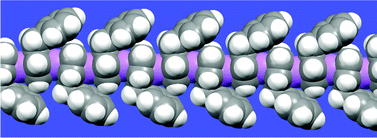
CrystEngComm, 2012,14, 6126-6128
https://doi.org/10.1039/C2CE25447F
Porous metal–organic framework based on a macrocyclic tetracarboxylate ligand exhibiting selective CO2 uptake
A two-fold interpenetrating microporous metal–organic framework, MMCF-1 has been constructed from a custom-designed macrocyclic ligand and it exhibits interesting selective uptake of CO2 over N2.
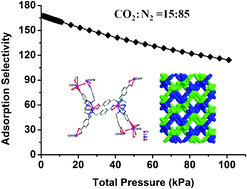
CrystEngComm, 2012,14, 6115-6117
https://doi.org/10.1039/C2CE25484K
Controlling the local arrangements of π-stacked polycyclic aromatic hydrocarbons through substituent effects
We show that the orientational behaviour of coronene and hexa-peri-hexabenzocoronene can be controlled via the through-space effects of simple substituents.
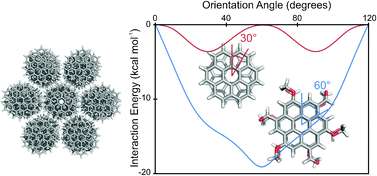
CrystEngComm, 2012,14, 6140-6145
https://doi.org/10.1039/C2CE25630D
Critical role of weak [C–H⋯O] hydrogen bonds in the assembly of benzo[1,2-d:4,5-d′]bisoxazole cruciforms into supramolecular sheets
A comparison of crystal structures of eight benzobisoxazole-based cruciform fluorophores reveals three distinct supramolecular organizational motives, brought about by the differences in terminal substitution.
![Graphical abstract: Critical role of weak [C–H⋯O] hydrogen bonds in the assembly of benzo[1,2-d:4,5-d′]bisoxazole cruciforms into supramolecular sheets](/en/Image/Get?imageInfo.ImageType=GA&imageInfo.ImageIdentifier.ManuscriptID=C2CE25485A&imageInfo.ImageIdentifier.Year=2012)
CrystEngComm, 2012,14, 6152-6162
https://doi.org/10.1039/C2CE25485A
Supramolecular networks in organic–inorganic hybrid materials from perchlorometalate(II) salts and 2,4,5-tri(4-pyridyl)imidazole
Crystal structure analysis of three crystalline organic–inorganic hybrid compounds prepared from a tripyridinium imidazolecation (L) and perhalometallate anions, reveals that L is a suitable ionic tecton for higher-dimensional networks.
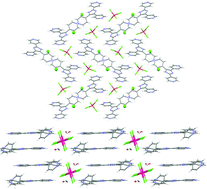
CrystEngComm, 2012,14, 6146-6151
https://doi.org/10.1039/C2CE25476J
Examining the robustness of a theophylline cocrystal during grinding with additives
The robustness of theophylline-p-hydroxybenzoic acid (TP·pHBA) while grinding with additives is evaluated through solvent-drop grinding experiments with coformers containing various functional groups.

CrystEngComm, 2012,14, 6163-6169
https://doi.org/10.1039/C2CE25495F
About this collection
This CrystEngComm Collection brings together a series of papers showcasing the excellent research being carried out in the Americas by younger members of the academic community.